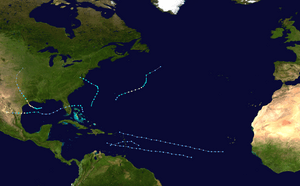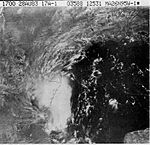1983 Atlantic hurricane season facts for kids
 |
|
| Season summary map | |
| First storm formed | July 23, 1983 |
|---|---|
| Last storm dissipated | September 30, 1983 |
| Strongest storm | Alicia – 962 mbar (hPa) (28.42 inHg), 115 mph (185 km/h) (1-minute sustained) |
| Total depressions | 7 |
| Total storms | 4 |
| Hurricanes | 3 |
| Major hurricanes (Cat. 3+) | 1 |
| Total fatalities | 22 total |
| Total damage | $3 billion (1983 USD) |
| Atlantic hurricane seasons 1981, 1982, 1983, 1984, 1985 |
|
| Related article | |
|
|
The 1983 Atlantic hurricane season was a time when tropical storms and hurricanes formed in the Atlantic Ocean. This season officially began on June 1, 1983, and ended on November 30. It was one of the quietest hurricane seasons ever recorded. There were only 4 named storms, which is much less than usual. It was also the least active season since scientists started measuring storm power using something called ACE in 1950.
The most powerful and damaging storm of the season was Hurricane Alicia. It hit Texas and caused a lot of destruction. Sadly, 21 people lost their lives directly because of this storm. The total damage from Alicia was about $2 billion.
Contents
Major Storms of 1983
Hurricane Alicia
| Category 3 tropical cyclone (SSHS) | |||
|---|---|---|---|
|
|||
| Duration | August 15, 1983 – August 21, 1983 | ||
| Intensity | 185 km/h (115 mph) (1-min), 962 hPa (mbar) | ||
Hurricane Alicia started in the middle of the Gulf of Mexico on August 15. It moved west and grew stronger, becoming a hurricane. It quickly reached Category 3 strength as it got close to the Texas coast. Alicia made landfall near Galveston, Texas on August 18 when it was at its strongest.
The storm then moved north, with its center passing over Houston. Alicia kept its tropical features even over land for a while. It eventually changed into a different type of storm and joined with another storm over northern Kansas on September 21. Alicia caused the deaths of 21 people. It also led to about $5.1 billion in damages (when adjusted to 2005 money value).
Hurricane Barry
| Category 1 tropical cyclone (SSHS) | |||
|---|---|---|---|
|
|||
| Duration | August 24, 1983 – August 29, 1983 | ||
| Intensity | 130 km/h (80 mph) (1-min), 986 hPa (mbar) | ||
A weather system from Africa traveled across the Atlantic Ocean. It became Tropical Storm Barry for a short time near the east coast of Florida on August 24. Barry weakened to a tropical depression just before it hit land near Melbourne, Florida. However, it crossed the Florida peninsula and continued west over the Gulf of Mexico.
In the central Gulf, Barry started to get stronger again. It became a basic Category 1 hurricane when it made landfall in northeastern Mexico. Barry then quickly weakened over land around August 29 and soon disappeared.
Hurricane Chantal
| Category 1 tropical cyclone (SSHS) | |||
|---|---|---|---|
|
|||
| Duration | September 10, 1983 – September 14, 1983 | ||
| Intensity | 120 km/h (75 mph) (1-min), 992 hPa (mbar) | ||
A group of thunderstorms about 200 km south of Bermuda grew into the fifth tropical depression of 1983. An Air Force plane found winds of 35 knots (40 mph or 65 km/h), and it was named Tropical Storm Chantal. Chantal continued to get stronger. It became a basic hurricane with 75 mph (120 km/h) winds on September 11. It stayed at this strength until September 13, when it weakened back into a tropical storm.
Chantal moved northeast over the open ocean, missing the island of Bermuda. It then weakened and was broken apart by another weather system on September 15. Since Chantal never hit land, no damage or deaths were reported. However, Chantal created huge waves, 30–40 feet (9–12 meters) high, along the East Coast of the United States.
Tropical Storm Dean
Tropical Storm Dean was a short-lived storm. It started as a subtropical storm between Bermuda and the Bahamas on September 26. The subtropical storm moved north-northeast and became a tropical storm the next day.
Warnings for strong winds were given from North Carolina to New England because of Dean. However, the storm turned northwest and hit the eastern shore of Virginia on September 30. The storm died out a few hours later. Dean was one of only two tropical storms to ever hit the eastern shore of Virginia. The other was Tropical Storm Bret in 1981. The overall damage from Dean was light, with only minor beach erosion and some flooding along parts of the Virginia coast.
Understanding Storm Power (ACE)
| ACE (104kt2) – Storm: | |||||||||||
|---|---|---|---|---|---|---|---|---|---|---|---|
| 1 | 6.38 | Alicia | 2 | 4.27 | Chantal | ||||||
| 3 | 3.14 | Barry | 4 | 3.07 | Dean | ||||||
| Total = 16.86 (17) | |||||||||||
The table on the right shows the ACE for each storm in the 1983 season. ACE is a way to measure how much power a hurricane has and how long it lasts. So, storms that are very strong or last for a long time will have a higher ACE score.
ACE is only calculated for tropical systems that have winds of at least 35 knots (39 mph or 63 km/h), which is tropical storm strength or higher. The 1983 season had a total ACE of 16.86 (which is rounded to 17). This is much lower than normal. In fact, it is the least active season on record since 1914, which had an ACE score of only 2.53.
Related Information
- More details on all storms from 1983 from NHC
|
Tropical cyclones of the 1983 Atlantic hurricane season |
|||||||||||||||||||||||
|
|
||||||||||||||||||||||
|
|
|||||||||||||||||||||||
|
Images for kids
-
Damage caused by a tornado or microburst related to Hurricane Alicia in Galveston County, Texas
See also
 In Spanish: Temporada de huracanes en el Atlántico de 1983 para niños
In Spanish: Temporada de huracanes en el Atlántico de 1983 para niños








